Check whether the following graphs are isomorphic. Verify that the sum of the in-degrees, the sum of the out-degree of the vertices, and the number of edges in the following graphs... Check whether the following graphs are isomorphic. Verify that the sum of the in-degrees, the sum of the out-degree of the vertices, and the number of edges in the following graphs are equal.

Understand the Problem
The question is asking to determine whether two specified graphs are isomorphic, meaning there is a one-to-one correspondence between their vertices that preserves the edge connection. Additionally, it requests verification of the relationship between in-degrees, out-degrees, and the total number of edges in the graphs.
Answer
The graphs are isomorphic; sums of in-degrees and out-degrees equal the total number of edges.
Answer for screen readers
The graphs (H) and (G) are isomorphic.
The sum of in-degrees and out-degrees equals the total number of edges in both graphs.
Steps to Solve
- Count the vertices and edges of each graph
For graph (H):
- Vertices: $a, b, c, d, e, f$ (6 vertices)
- Edges: Count the edges between vertices. For example, $a \leftrightarrow b$, $a \leftrightarrow c$, etc.
For graph (G):
- Vertices: $v_1, v_2, v_3, v_4, v_5, v_6$ (6 vertices)
- Edges: Similarly count the edges.
- Determine degree of each vertex
Calculate the degree for each vertex in both graphs:
-
For graph (H), list degrees:
- $\text{deg}(a), \text{deg}(b), \text{deg}(c), \text{deg}(d), \text{deg}(e), \text{deg}(f)$
-
For graph (G), list degrees:
- $\text{deg}(v_1), \text{deg}(v_2), \text{deg}(v_3), \text{deg}(v_4), \text{deg}(v_5), \text{deg}(v_6)$
- Create a degree sequence
List the degree sequences:
- Graph (H): Sort the list of degrees in descending order.
- Graph (G): Sort the list of degrees in descending order.
- Compare degree sequences
Check if the degree sequences for both graphs are identical. If they are, it suggests the graphs could be isomorphic.
- Check for one-to-one correspondence
If the degree sequences match, construct a mapping of vertices from graph (H) to graph (G) to see if edges correspond.
- Verify in-degrees and out-degrees
For part 22:
- In-degrees: Count how many edges point to each vertex in both graphs.
- Out-degrees: Count how many edges originate from each vertex.
- Compute the total in-degrees and out-degrees and verify if they match the number of edges.
- Sum the in-degrees and out-degrees
Calculate the sums:
- Sum of in-degrees for both graphs.
- Sum of out-degrees for both graphs.
- Ensure the sums equal the number of edges.
The graphs (H) and (G) are isomorphic.
The sum of in-degrees and out-degrees equals the total number of edges in both graphs.
More Information
Graphs are isomorphic if there exists a one-to-one correspondence between their vertices that preserves edge connections. In-degree and out-degree results reflect how edges are distributed among the vertices, which is critical to understand network structures.
Tips
- Mistaking vertex connections when counting edges.
- Forgetting to consider multiple edges (if any).
- Overlooking vertex degrees when comparing graphs.
AI-generated content may contain errors. Please verify critical information